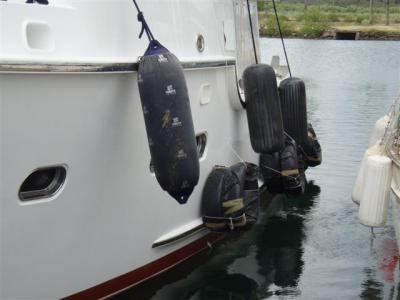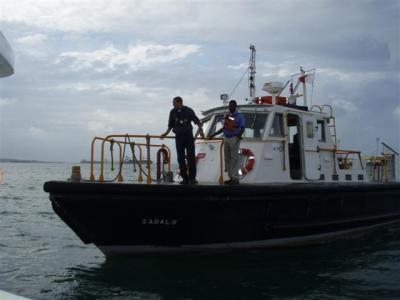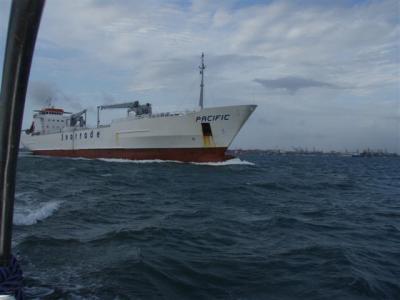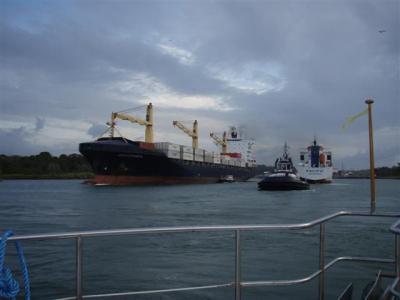Christi was up at 0500, feeling absolutely miserable with her stomach worse than ever. She was making even more frequent trips to the restroom and now had stomach pain. In the early hour before dawn, the Howler Monkeys were moaning and groaning like crazy. It is really an eerie sound to begin with, and even eerier to hear when you aren’t in the jungle. It made the new day feel almost ominous. They sounded so close. Were the monkeys in the marina or was the sound carrying from the jungle? When the sun came up, she saw the sky was overcast with big, dark, threatening clouds. There were intermittent short bursts of rain and it was really windy.
At 0800, everyone else was up and we got to work on getting the boat ready to go. Eric installed the new blower that Jeff had brought. It should have been a quick project, but unfortunately, the repair guy in Antigua had taken the mounting bracket with him when he took the blower away, but had not returned the mounting bracket with the blower. So, Eric had to custom-build a new mounting bracket. It took a lot longer than anticipated.
We were supposed to cover our solar panels. We couldn’t figure out what to put up there and how to secure it so it stayed on. After trying multiple things that blew away, we finally decided to skip it. Our solar cells are on top of the pilot house, which is so far away from where they would be throwing the lines to that we didn’t think anything would happen. Had our solar panels been in a more vulnerable spot, as is the case on most sailboats, covering the solar panels would be crucial.
Christi had to do some serious reorganizing to make room for all the people we would be having aboard. And, of course, we had to do all the normal “get ready to go to sea” stuff. We also did a flurry of last minute socializing in between boat chores.
At noon, our two professional line handlers that Victor had arranged for us, Edgar and Joel showed up. We know, you are wondering why we would hire two professional line handlers when we already have the required 5 people between Jeff, Tom, Susan, Christi and Eric? Eric felt strongly that it was important to have professionals on board who have been through many times and would know what to do in case of an emergency, one in front and one in back. Christi also decided that she should not handle lines because she is not very good with lines. While the line handling is not difficult, it does require good speed to keep the boat properly tensioned, and she is very slow. If the tension is too loose, the boat will fall out of proper position, making a crash possible, and if the tension is too tight, it could cause damage to the boat. She chose to play the role of videographer, instead.
Edgar and Joel immediately went to work on the tires. They tied two together to make extra fat fenders and then attached lines to them to hang them from the sides. Unfortunately, we didn’t have many suitable extra lines on board, so many of the tire fenders were hung with twine.


In the early afternoon, probably an hour or so before we planned to depart, yet another Nordhavn pulled into the marina. It was another 43! Unfortunately, all we had time for was a quick hi and bye.
At 1430, Tom and Susan arrived. We had an official meeting where we went over all the standard safety stuff that we do with all our new crew. We showed everyone where to find safety/first aid gear in case of an emergency, how to use key pieces of equipment, like the radio, and what is dangerous and needs to be steered clear of, like the rotating radar antenna, and so forth. We also did an orientation on where to find things in general, like food and toiletries. Then we discussed the procedures for the canal transit. Jeff, Tom and Susan have all been through once before, so the only newbies to the process were Eric and Christi.
Eric tried to start the engine at 1520, but the battery was still dead. The equalizing hadn’t done the trick. The poor starter battery leads a hard life. Eric went down to parallel the house batteries to the starter battery and started her right up at 1522. We departed the dock at 1530. As soon as we were out of the marina and in the bay, Eric did as the cruising guide had instructed and called Cristobal Control to tell them we were on our way. There was no response. He tried again and got no response. Over the last few days, he had heard other boats calling Cristobal Signal, so the next time, he called Cristobal Signal and got an immediate reply. So FYI, the control tower does not respond to Cristobal Control.
They told us to proceed to “the flats”, a designated area within the bay marked on the charts and surrounded by buoys. They said we would pick up our advisor at 1630. We proceeded over to the flats, which are located near the new cruise ship terminal in Colon. Since we had lots of time to get there, we went slow. When we neared the shipping lane, we got a call on the radio from the control tower directing us to cross the lane after the approaching container ship had passed us. Eric had just been about to call and ask permission to cross the lane. We also heard a couple discussions in Spanish where they definitely said Kosmos a few times, so we knew that something was going on that involved us.
We arrived to “the flats” at 1620 and started doing circles. About the same time, we heard the control tower strongly chastising a sailboat that had entered the bay without permission. The control tower was obviously watching everything in the bay like a hawk. At 1640, a pilot boat pulled up along side us. The pilot boat driver is incredibly skilled, getting to within a couple inches of us without ever touching. He hovered so steadily and so close to us that the advisor stepped from their boat onto ours as easily and gracefully as if he was walking on terra firma. You can certainly tell the captain of this vessel does this all day every day.

Our advisor’s name is Moises and he seemed like a nice guy from the get go. He told us we would be going “center lock”, meaning we weren’t tied to anyone else, which made us happy. We were scheduled to be boat number 26, sharing the lock with a Chiquita bulk cargo vessel. But a minute later, he talked on the radio with the control tower and announced that since we were ready to go now, we’d been moved up to boat number 24 and would be sharing the lock with Pacific, another bulk cargo carrier. How funny that we were going to the Pacific with the Pacific.
At 1650 we departed the flats and headed towards the canal channel, a man made channel that leads to the first lock. Moises explained that he was directed via radio by the control towers as to what to do, then would pass the instructions on to the rest of us. Moises told us what speed to maintain, how close we should be to the channel markers, etc, based on the other traffic around us. Moises pointed out where they were building the new addition to the canal, using the remains of the original French canal. When the Americans had taken over, they diverted the canal from the original route the French had started.
At first the boats were all passing one another, but within a few minutes, we were all in a single file line in the right order. Our lock mate, Pacific, was directly in front of us. When Pacific had passed us, Joel and Susan saw a dolphin playing on its bow.

Some of the big boats were accompanied by tugs. The tugs don’t do the transit. Big ships have poor maneuverability at slow speeds, so the tugs are there to help the ships get the cables in place, then turn around once the ship is situated. There was also a steady stream of traffic coming from the locks, including some massively large ships. A guy on one of the tugs going the other way shouted at us “nice looking boat!”

To be continued”¦
